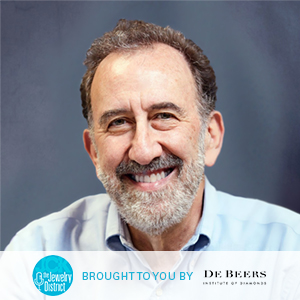
JCK editor-in-chief Victoria Gomelsky and news director Rob Bates talk with Stanley Zale, principal consultant at Hill & Co. and grandson of Zale Corporation founder M.B. Zale. Stanley reflects on growing up in one of the industry’s most famous families, a childhood that included spending school vacations with a loupe and tweezer examining diamonds. He also draws from more than 40 years of experience in diamonds to offer predictions about what jewelers should expect in 2024 (modest growth) and how to make the most of it (don’t speculate, but be quick to react).
Sponsored by De Beers: institute.debeers.com
Show Notes
02:40 What’s ahead in 2024?
06:00 Born into diamonds
15:11 The silver lining of selling the family business
17:58 Inroads in the lab-grown market
21:15 How to play it smart this year
Episode Credits
Hosts: Rob Bates and Victoria Gomelsky
Producer and engineer: Natalie Chomet
Editor: Riley McCaskill
Plugs: @jckmagazine; institute.debeers.com; Hill & Co.
Show Recap
What’s ahead in 2024?
Victoria introduces Stanley Zale, scion of the illustrious Zale family, former VP of diamond and gemstone procurement for Stuller, and now principal consultant at growth strategy specialists Hill & Co. With 2023 holiday sales generating moderate growth, Stanley encourages jewelers to “right-size” their expectations for the coming year. Think of 2019 as a benchmark.
Rob asks what’s triggering these more modest sales numbers—the end of the pandemic, jewelry fatigue, or other factors? Sales are essentially recalibrating after excessive growth during the COVID years, Stanley says. They’re getting back to where they would have been without the pandemic spike. While that might not be cause for celebration, Stanley says he’s optimistic about the year ahead.
Born into diamonds
A hundred years ago, Stanley’s grandfather M. B. Zale opened the first Zales store, in Wichita Falls, Texas. As the company grew, Stanley’s father, Marvin, took charge of the New York City office, where merchandising and manufacturing were centered. (Zales started cutting diamonds from rough in the 1950s and became a De Beers sightholder in the late 1960s.) “When I was 14 or so, my father and grandfather said, ‘If you want to learn the diamond business, we’ll teach you.’ I said, ‘Sure!’” Stanley recalls. “So on school and summer vacations, I’d be in the New York office with a loupe and a tweezer…testing my dexterity” on the smallest diamonds Zales sold.
At 17, Stanley became a sawyer at his family’s sawing factory in Manhattan, where he learned from “some of the best in the business” how to maximize the yield and, therefore, the value of rough diamonds. “It was a great education,” he says.
Rob mentions the new memoir by Stanley’s uncle Don—Nobody Gets Hurt at the Office: The Life & Legacy of M.B. Zale—and asks about the title. It stems from incidents when employees couldn’t come to work after injuring themselves over the weekend, Stanley explains. Ever practical and business-minded, M.B. pointed out that if the employees had been at work, their accidents wouldn’t have happened and they wouldn’t have gotten hurt.
Stanley praises the book for capturing the immigrant experience of the early 20th century, when waves of newcomers from Eastern Europe arrived in America. Some, like M.B. Zale, made their way to Texas during the oil boom. “It’s the ultimate American success story,” says Stanley of his grandfather.
M.B. built the Zale business not just through hard work but with forward-thinking business strategies. “His innovation was selling on credit, layaway,” Stanley says. “Back then, jewelry was really only something for the carriage trade. The average worker didn’t have the opportunity to buy jewelry because they didn’t have the money.” M.B. also took advantage of opportunities to open stores in new cities and had the foresight to source diamonds in Antwerp starting in 1948, a challenging effort so soon after World War II.
The silver lining of selling the family business
Rob asks about the 1986 sale of Zales to Peoples Jewellers, which led to bankruptcy and its subsequent purchase by Signet Jewelers. Did the company lose its way without M.B. as a guiding light? Stanley says that the sale involved a leveraged buyout that saddled the Zale Corporation with massive debt, forcing it to reduce overhead. To curb costs, the brand stopped cutting its own diamonds and manufacturing its own jewelry. “By eliminating those expenses, superficially it looks like a money saver,” Stanley says. “The flip side is your cost of goods goes up. Your product costs you more. You’re paying interest on debt. Inevitably it went bankrupt.”
Fortunately, Zales is in good hands now with Signet, in Stanley’s opinion. And he’s proud to see his grandfather’s legacy alive and well. “There aren’t many American retail institutions that are 100 years old,” he states.
Selling the business had a silver lining for the Zale family: They turned their attention to the M.B. & Edna Zale Foundation, a charitable organization Stanley’s grandparents founded in the 1950s. “Where a for-profit enterprise could start to create some wedges in the family, the family business of giving away money to help people brings us together in ways I never could have imagined before,” he says.
Inroads in the lab-grown market
Rob notes that Stanley had focused on natural diamonds at Stuller, but the company became a major player in the lab-grown market. How did that unfold? In 2012, Stanley and his colleagues read that IGI Antwerp had discovered hundreds of undisclosed lab-grown diamonds. “This hit everyone like a shock,” Stanley recalls. Realizing there could be many more undisclosed lab-grown diamonds on the market, Stuller started checking every diamond larger than 20 points with short-wave UV screening technology. They vetted nearly 6,000 stones and found 30 that raised suspicion. An outside lab confirmed that the diamonds were indeed natural. By 2017, Stuller was screening all its diamonds. Once technology had improved and Stuller became confident in its ability to discern the type of stone, the company introduced lab-grown diamonds into the product mix.
“Someone said to me soon after that, ‘What would your grandfather say if he knew you were selling lab-grown diamonds?’” Stanley remembers. Zales had faced a similar quandary in the early 1950s, when the first synthetic diamonds were produced. Fearing mass-produced diamonds might destroy the jewelry business, Zales diversified. The company bought sporting goods stores, drugstores, furniture stores, and airport newsstands. “Ultimately they came to the conclusion that they were in the jewelry business—not the diamond business,” Stanley says. “It’s about how someone chooses to adorn themselves with a piece of jewelry, and we’re not going to pass judgment.”
How to play it smart this year
Victoria asks about Stanley’s new job at Hill & Co. His mission, he explains, is to help clients maximize profitability in both up and down markets by tapping into strategies like smarter inventory management and better understanding of supply issues.
How does that apply to the year ahead? “I’m sensing that there’s going to be a level of modest growth,” Stanley says. His advice: “Don’t speculate. Be quick to react as markets change…. Play it safely, play it a little bit conservatively, and I think it’ll be okay.”
Any views expressed in this podcast do not reflect the opinion of JCK, its management, or its advertisers.
- Subscribe to the JCK News Daily
- Subscribe to the JCK Special Report
- Follow JCK on Instagram: @jckmagazine
- Follow JCK on X: @jckmagazine
- Follow JCK on Facebook: @jckmagazine





